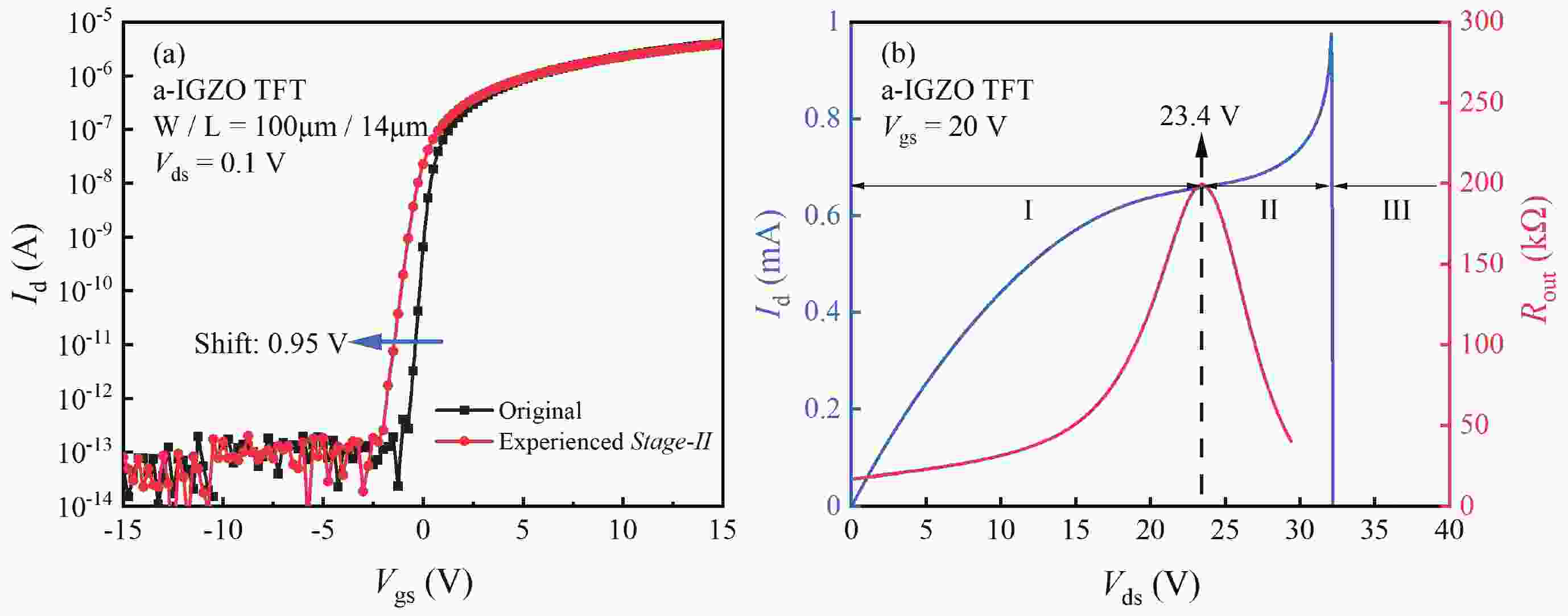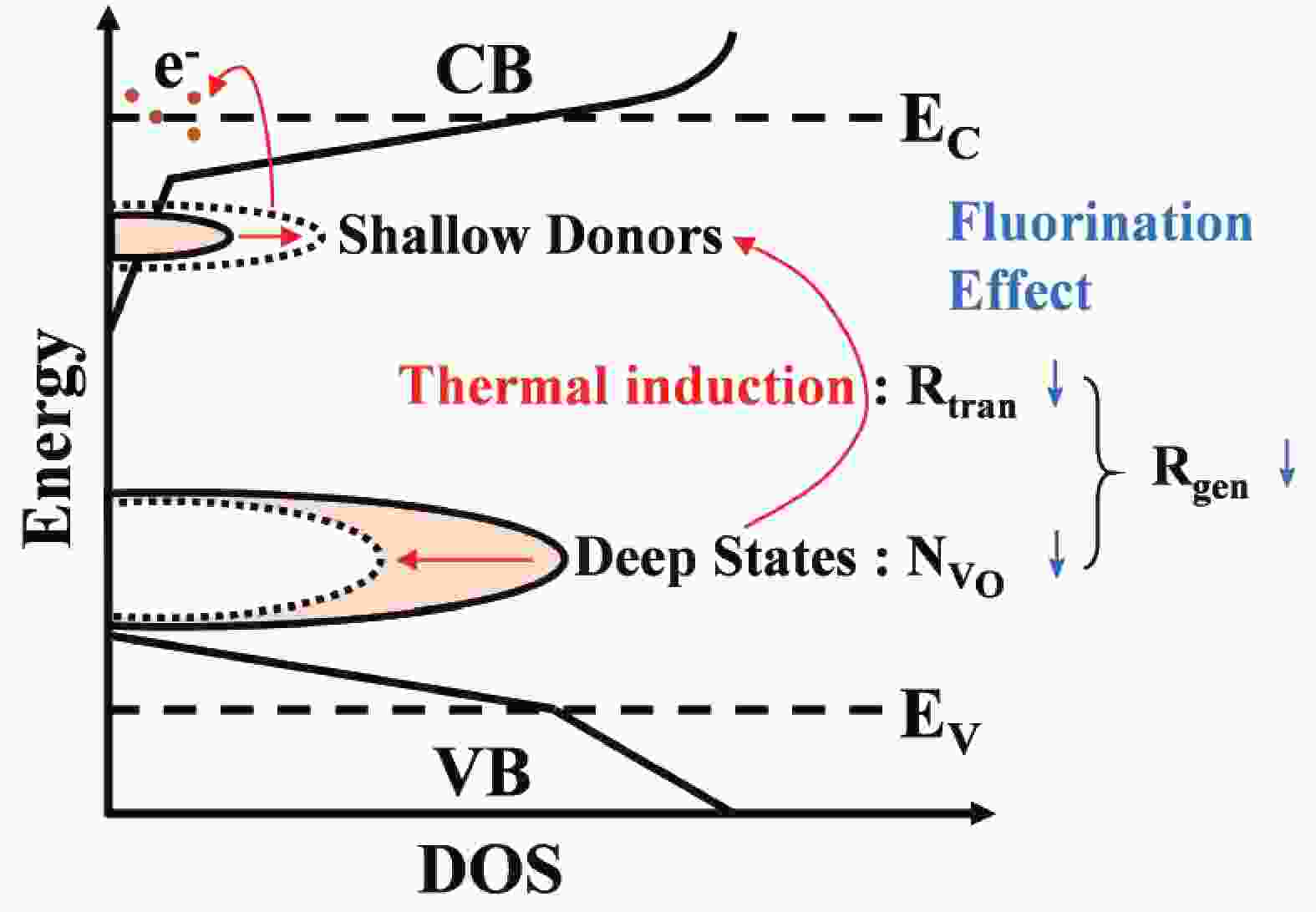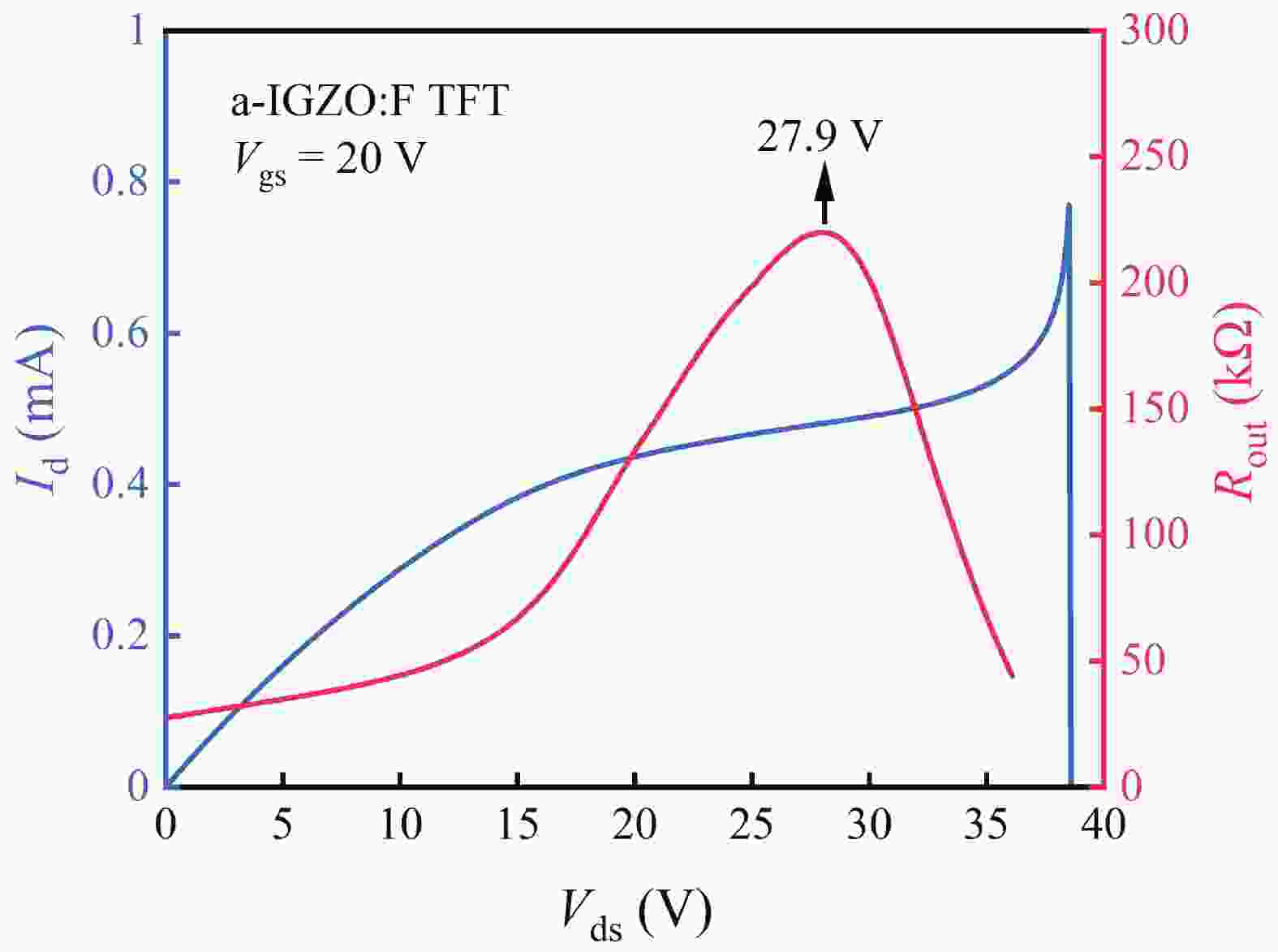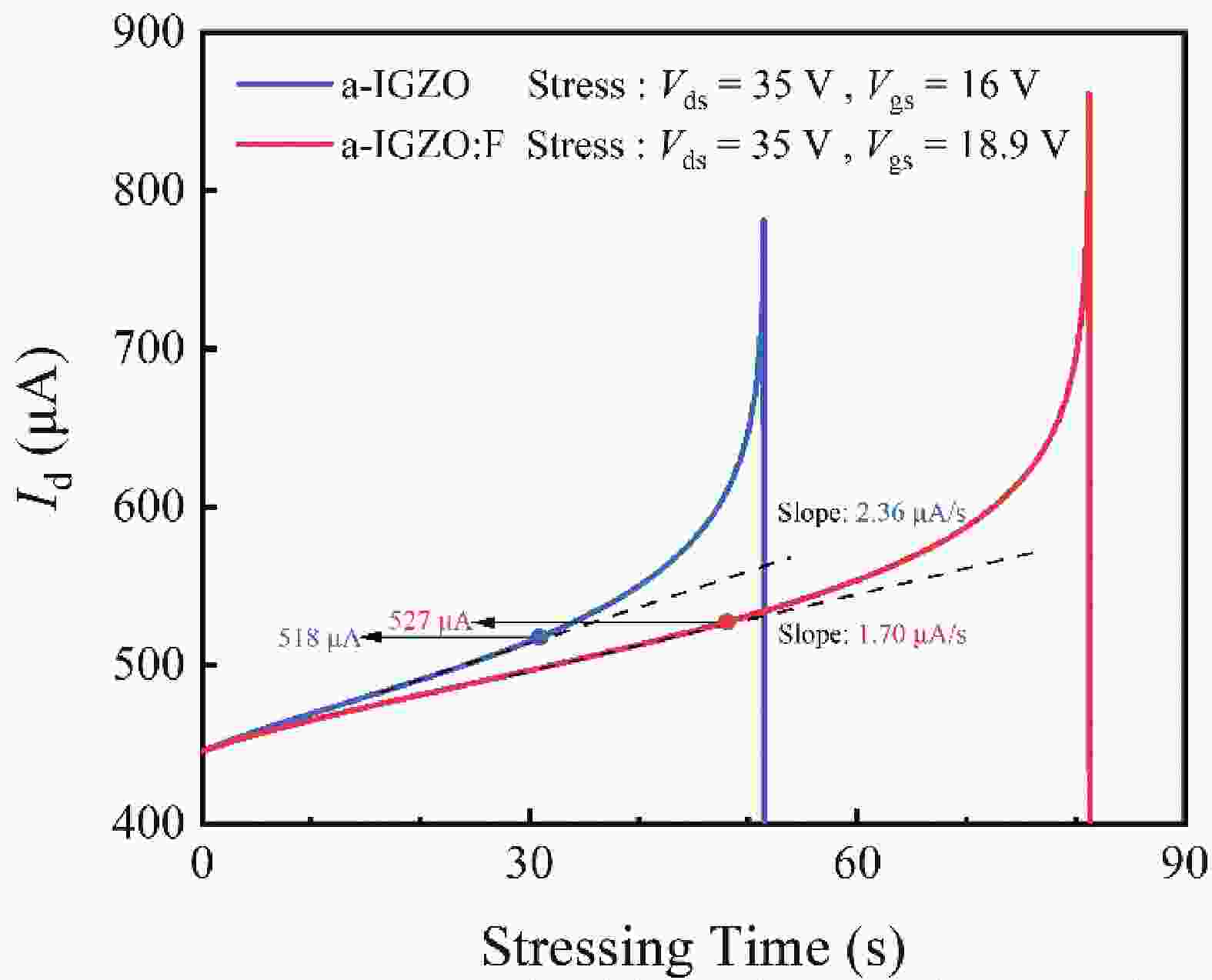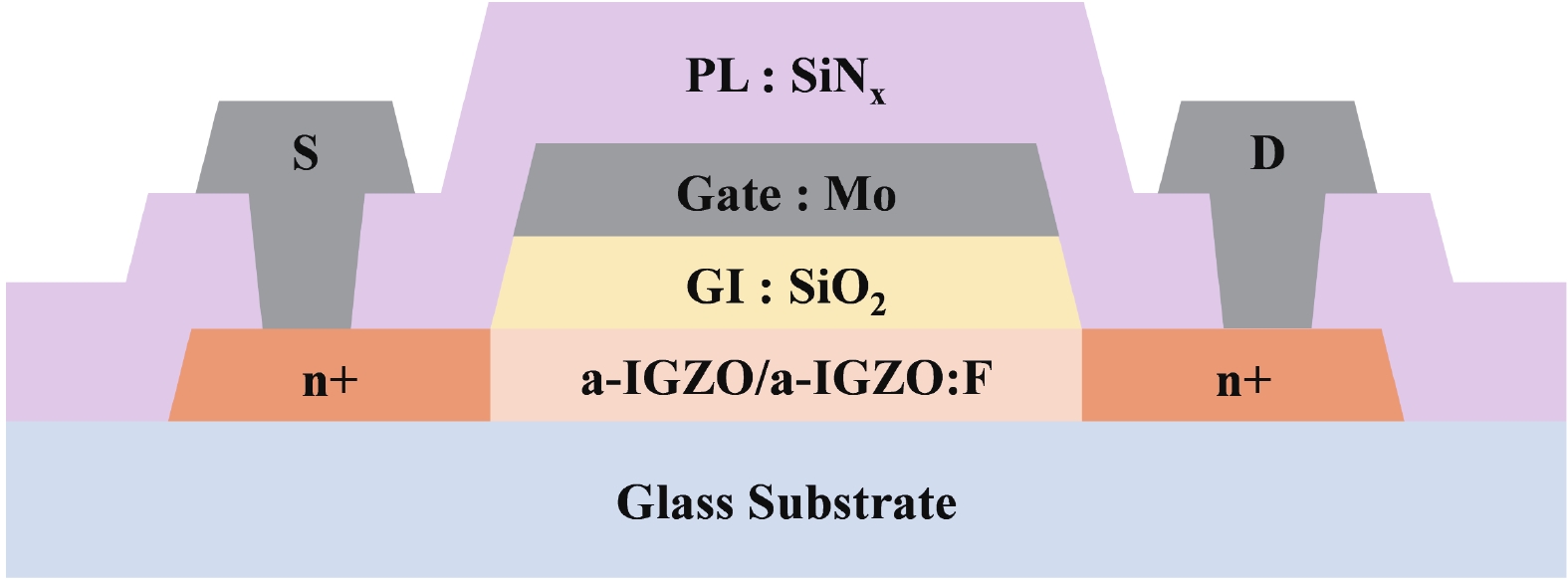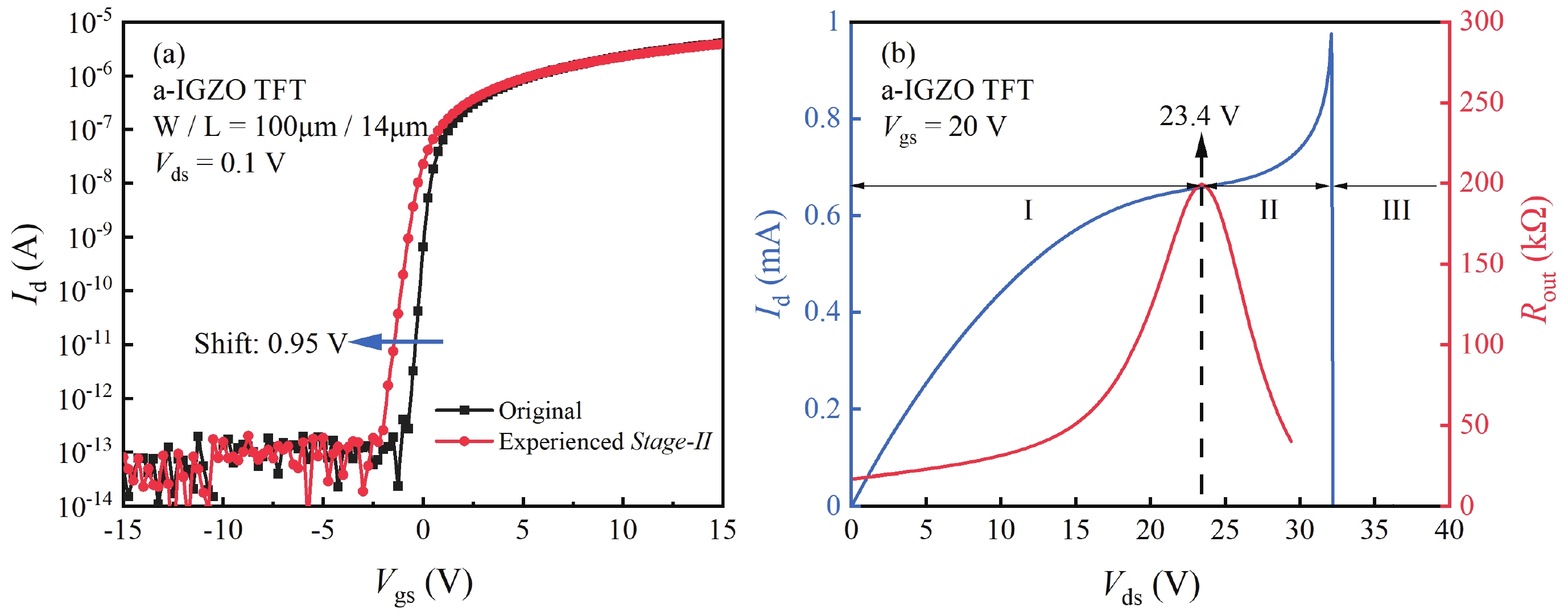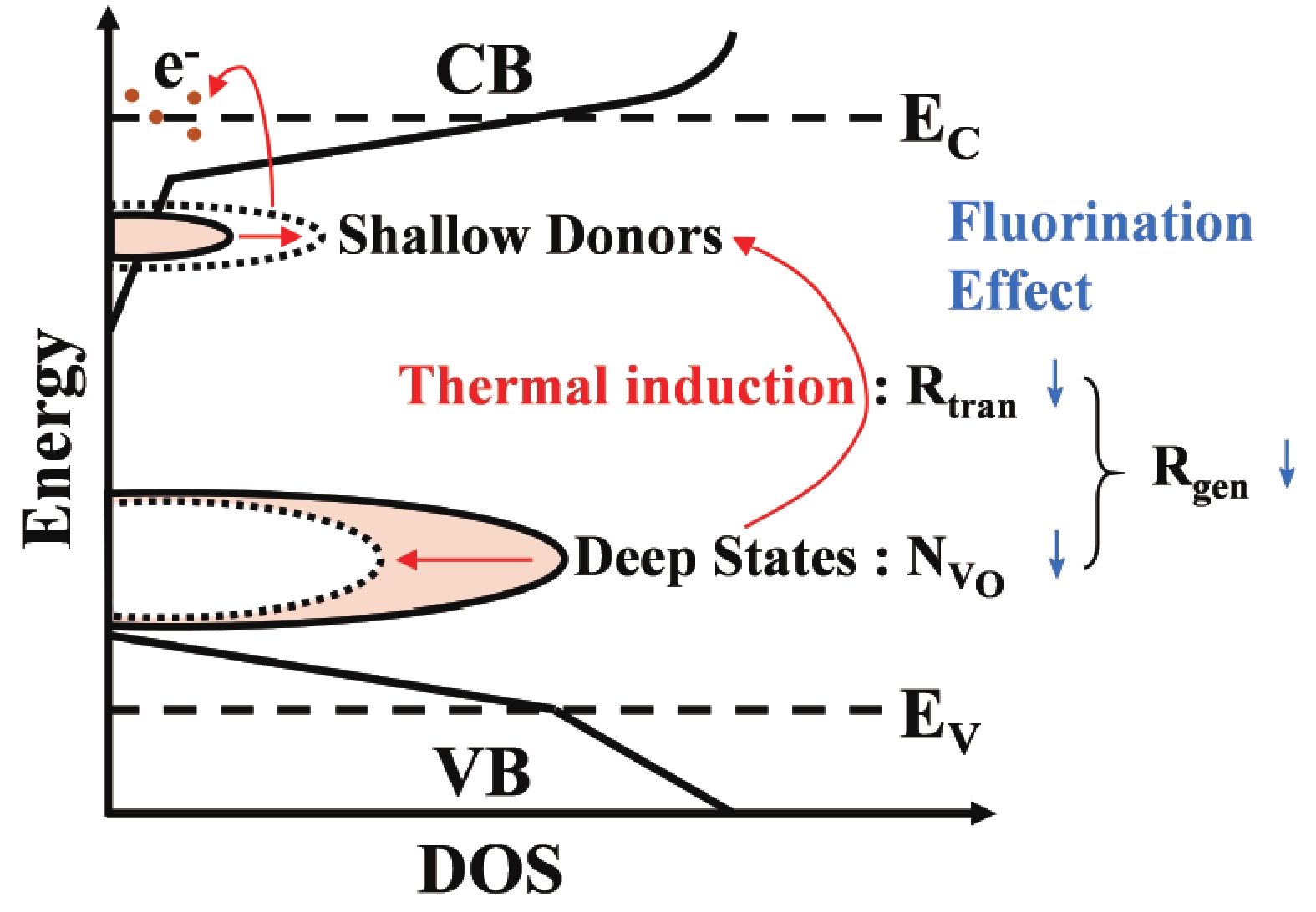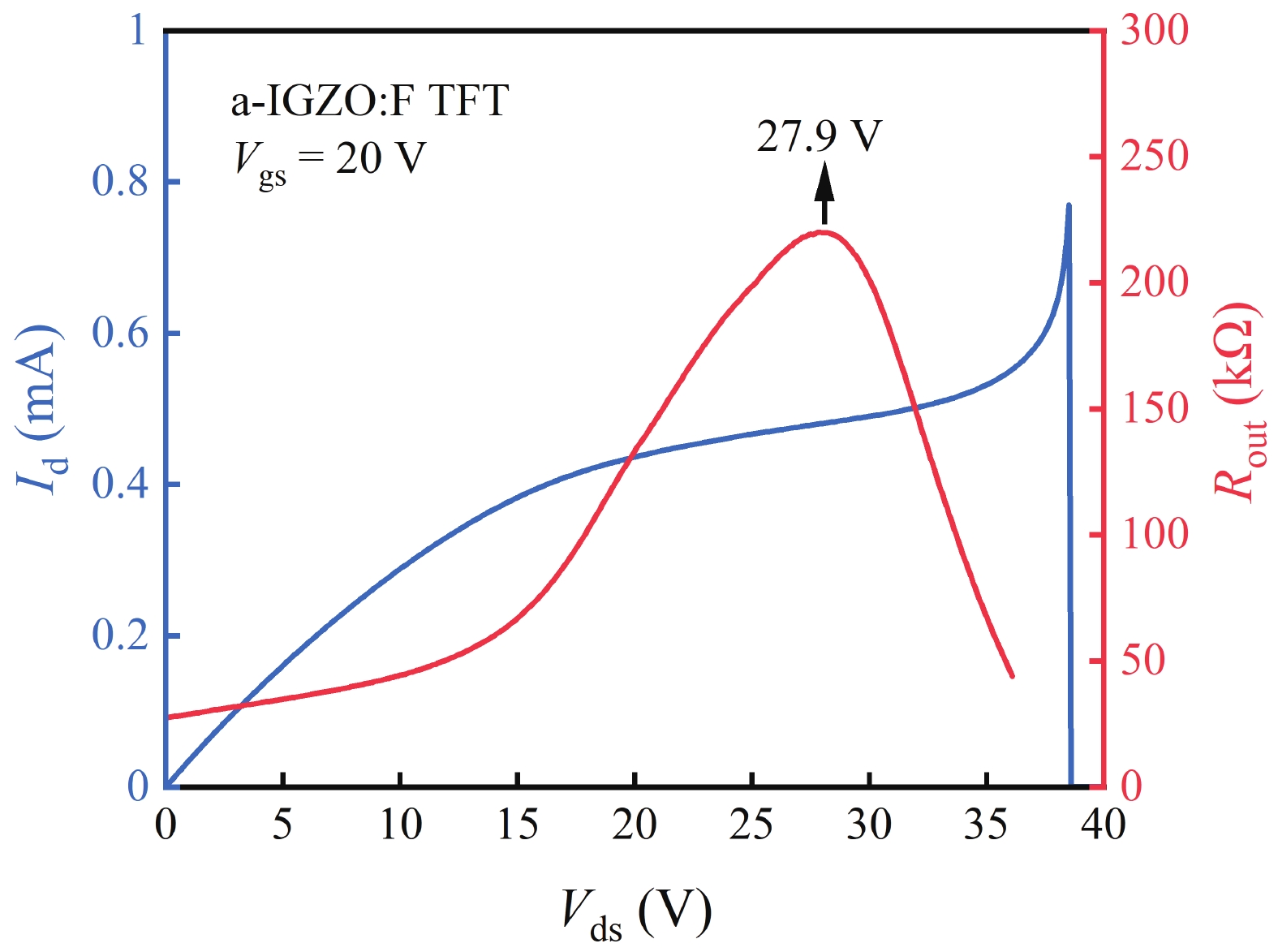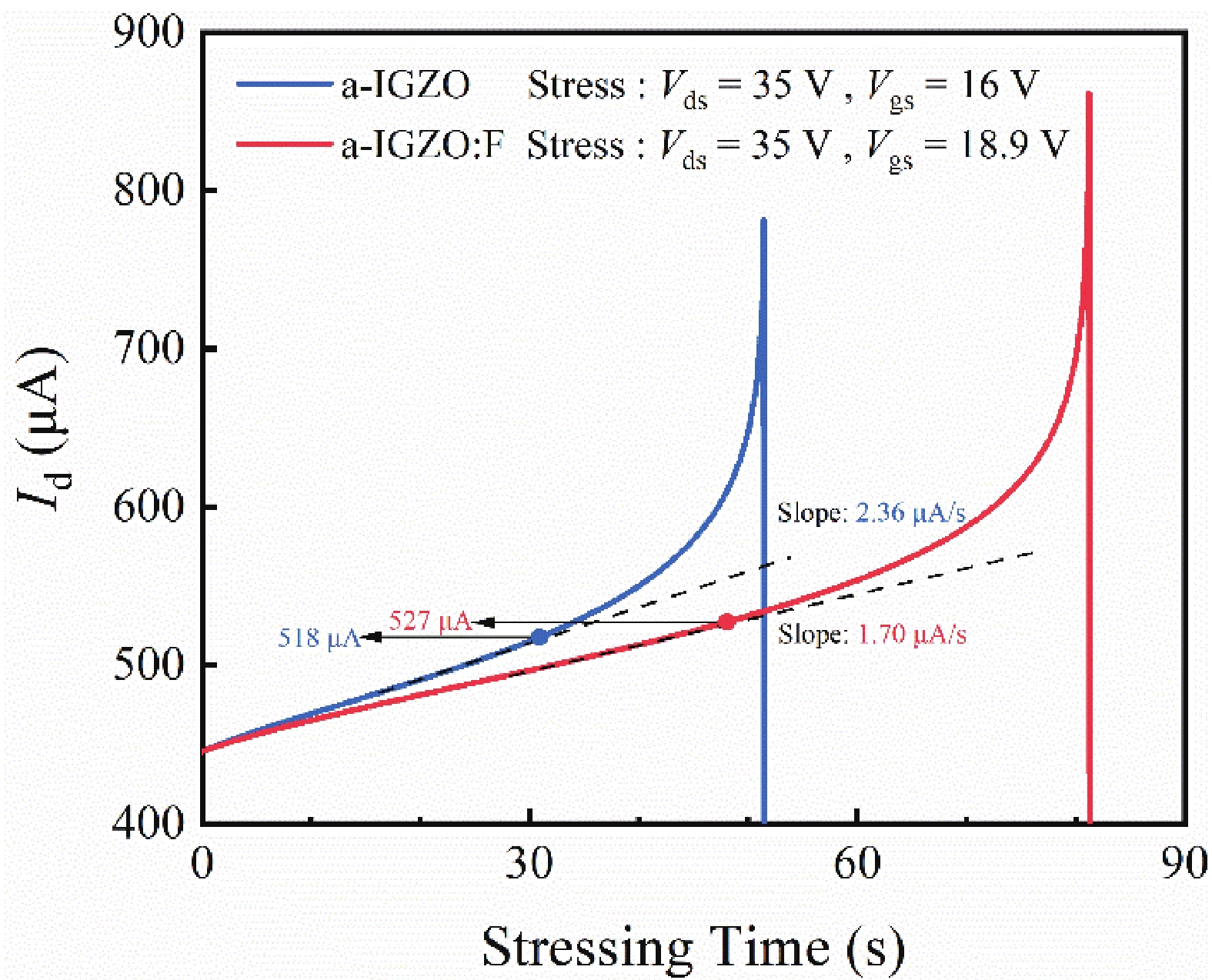| Citation: |
Yanxin Wang, Jiye Li, Fayang Liu, Dongxiang Luo, Yunping Wang, Shengdong Zhang, Lei Lu. Fluorination-mitigated high-current degradation of amorphous InGaZnO thin-film transistors[J]. Journal of Semiconductors, 2023, 44(9): 092601. doi: 10.1088/1674-4926/44/9/092601
Y X Wang, J Y Li, F Y Liu, D X Luo, Y P Wang, S D Zhang, L Lu. Fluorination-mitigated high-current degradation of amorphous InGaZnO thin-film transistors[J]. J. Semicond, 2023, 44(9): 092601. doi: 10.1088/1674-4926/44/9/092601
Export: BibTex EndNote
|
Fluorination-mitigated high-current degradation of amorphous InGaZnO thin-film transistors
doi: 10.1088/1674-4926/44/9/092601
More Information-
Abstract
As growing applications demand higher driving currents of oxide semiconductor thin-film transistors (TFTs), severe instabilities and even hard breakdown under high-current stress (HCS) become critical challenges. In this work, the triggering voltage of HCS-induced self-heating (SH) degradation is defined in the output characteristics of amorphous indium-gallium-zinc oxide (a-IGZO) TFTs, and used to quantitatively evaluate the thermal generation process of channel donor defects. The fluorinated a-IGZO (a-IGZO:F) was adopted to effectively retard the triggering of the self-heating (SH) effect, and was supposed to originate from the less population of initial deep-state defects and a slower rate of thermal defect transition in a-IGZO:F. The proposed scheme noticeably enhances the high-current applications of oxide TFTs. -
References
[1] Hsieh H H, Lu H H, Ting H C, et al. Development of IGZO TFTs and their applications to next-generation flat-panel displays. J Inf Disp, 2010, 11(4), 160 doi: 10.1080/15980316.2010.9665845[2] Nomura K, Takagi A, Kamiya T, et al. Amorphous oxide semiconductors for high-performance flexible thin-film transistors. Jpn J Appl Phys, 2006, 45, 4303 doi: 10.1143/JJAP.45.4303[3] Tang L F, Lu H, Ren F F, et al. Electrical instability of amorphous-indium-gallium-zinc-oxide thin-film transistors under ultraviolet illumination. Chin Phys Lett, 2016, 33, 038502 doi: 10.1088/0256-307X/33/3/038502[4] Chasin A, Franco J, Triantopoulos K, et al. Understanding and modelling the PBTI reliability of thin-film IGZO transistors. 2021 IEEE International Electron Devices Meeting (IEDM), 2022, 31 doi: 10.1109/IEDM19574.2021.9720666[5] Zheng Z K, Li S, Li Y Z, et al. P-6: Reduction of drain-current-drop phenomenon in BCE a-IGZO TFTs for 85-in. 8K 120Hz GOA LCD. SID Symp Dig Tech Pap, 2021, 52, 1078 doi: 10.1002/sdtp.14879[6] Kim J, Miyokawa N, Ide K, et al. Room-temperature fabrication of light-emitting thin films based on amorphous oxide semiconductor. AIP Adv, 2016, 6(1), 015106 doi: 10.1063/1.4939939[7] Choi J W, Song D H, Chun H I, et al. 30-5: Late-News Paper: Glass-based High brightness AMLED using Dual Gate Coplanar a-IGZO TFT. SID Symp Dig Tech Pap, 2020, 51, 440 doi: 10.1002/sdtp.13899[8] Du M, Zhao J, Zhang D, et al. Roles of gate voltage and stress power in self-heating degradation of a-InGaZnO thin-film transistors. IEEE Trans Electron Devices, 2021, 68(4), 1644 doi: 10.1109/TED.2021.3055751[9] Chen H C, Chen J J, Tu Y F, et al. Abnormal hump effect induced by hydrogen diffusion during self-heating stress in top-gate amorphous InGaZnO TFTs. IEEE Trans Electron Devices, 2020, 67(7), 2807 doi: 10.1109/TED.2020.2994539[10] Yang H, Huang T Y, Zhou X L, et al. Self-heating stress-induced severe humps in transfer characteristics of amorphous InGaZnO thin-film transistors. IEEE Trans Electron Devices, 2021, 68, 6197 doi: 10.1109/TED.2021.3122792[11] Lee S W, Jeon P J, Choi K, et al. Analysis of self-heating effect on short channel amorphous InGaZnO thin-film transistors. IEEE Electron Device Lett, 2015, 36(5), 472 doi: 10.1109/LED.2015.2411742[12] Liu F Y, Zhou Y H, Yang H, et al. Roles of hot carriers in dynamic self-heating degradation of a-InGaZnO thin-film transistors. IEEE Electron Device Lett, 2022, 43, 40 doi: 10.1109/LED.2021.3133011[13] Mativenga M, Hong S, Jang J. High current stress effects in amorphous-InGaZnO4 thin-film transistors. Appl Phys Lett, 2013, 102(2), 023503 doi: 10.1063/1.4775694[14] Yeon H W, Lim S M, Jung J K, et al. Structural-relaxation-driven electron doping of amorphous oxide semiconductors by increasing the concentration of oxygen vacancies in shallow-donor states. NPG Asia Mater, 2016, 8(3), e250 doi: 10.1038/am.2016.11[15] Chen H C, Chen G F, Chen P H, et al. A novel heat dissipation structure for inhibiting hydrogen diffusion in top-gate a-InGaZnO TFTs. IEEE Electron Device Lett, 2019, 40(9), 1447 doi: 10.1109/LED.2019.2927422[16] Liao P Y, Khot K, Alajlouni S, et al. Alleviation of self-heating effect in top-gated ultrathin In2O3 FETs using a thermal adhesion layer. IEEE Trans Electron Devices, 2023, 70, 113 doi: 10.1109/TED.2022.3221358[17] Yang T J, Kim J H, Cho J R, et al. Physical model of a local threshold voltage shift in InGaZnO thin-film transistors under current stress for instability-aware circuit design. Curr Appl Phys, 2023, 46, 55 doi: 10.1016/j.cap.2022.11.011[18] Nomura K, Kamiya T, Kikuchi Y, et al. Comprehensive studies on the stabilities of a-In-Ga-Zn-O based thin film transistor by constant current stress. Thin Solid Films, 2010, 518(11), 3012 doi: 10.1016/j.tsf.2009.09.193[19] Oh C E, Kwon H I, Jeong H S, et al. Effects of oxygen content on output characteristics of IGZO TFTs under high current driving conditions. J Semicond Technol Sci, 2023, 23, 71 doi: 10.5573/JSTS.2023.23.1.71[20] Wang C, Peng C, Wen P, et al. Improvement of performance of back channel etching InGaZnO thin-film transistors by CF4 plasma treatment. IEEE Trans Electron Devices, 2023, 70, 1687 doi: 10.1109/TED.2023.3244903[21] Lu L, Xia Z H, Li J P, et al. A comparative study on fluorination and oxidation of indium–gallium–zinc oxide thin-film transistors. IEEE Electron Device Lett, 2018, 39, 196 doi: 10.1109/LED.2017.2781700[22] Zhou Y H, Liu F Y, Yang H, et al. Competition between heating and cooling during dynamic self-heating degradation of amorphous InGaZnO thin-film transistors. Solid State Electron, 2022, 195, 108393 doi: 10.1016/j.sse.2022.108393[23] Feng Z Q, Lu L, Wang S S, et al. Fluorination-enabled monolithic integration of enhancement- and depletion-mode indium-gallium-zinc oxide TFTs. IEEE Electron Device Lett, 2018, 39, 692 doi: 10.1109/LED.2018.2818949[24] Park Y C, Um J G, Mativenga M, et al. Thermal stability improvement of back channel etched a-IGZO TFTs by using fluorinated organic passivation. ECS J Solid State Sci Technol, 2018, 7(6), Q123 doi: 10.1149/2.0251806jss[25] Saha J K, Ali A, Bukke R N, et al. Performance improvement for spray-coated ZnO TFT by F doping with spray-coated Zr–Al–O gate insulator. IEEE Trans Electron Devices, 2021, 68(3), 1063 doi: 10.1109/TED.2021.3051918[26] Wang S S, Li J P, Shi R X, et al. Fluorinated indium-gallium-zinc oxide thin-film transistor with reduced vulnerability to hydrogen-induced degradation. J Soc Inf Display, 2020, 28, 520 doi: 10.1002/jsid.914[27] Wang S S, Shi R X, Li J P, et al. Resilience of fluorinated indium-gallium-zinc oxide thin-film transistor against hydrogen-induced degradation. IEEE Electron Device Lett, 2020, 41, 729 doi: 10.1109/LED.2020.2983789[28] Yoshikawa T, Yagi T, Oka N, et al. Thermal conductivity of amorphous indium–gallium–zinc oxide thin films. Appl Phys Express, 2013, 6(2), 021101 doi: 10.7567/APEX.6.021101 -
Proportional views






 DownLoad:
DownLoad:
